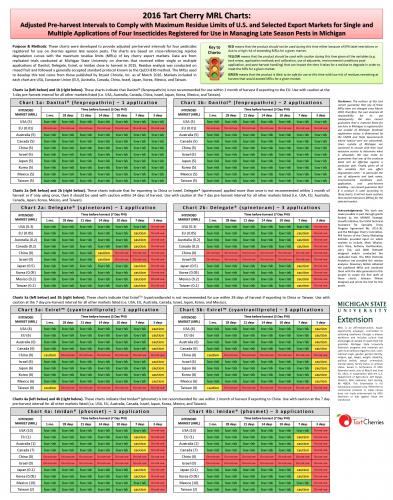Pest Management
MSU recommends the use of Integrated Pest Management (IPM), a combination of common-sense practices. Decisions are made based on pest lifecycles and their interaction with the environment. Chosen pest control methods are used to manage pest damage by the most economical means, and with the least possible hazard to people, property and the environment.
Try our Pest and Beneficial Search
Use the pest and beneficial search to identify diseases, insect and mite pests and beneficials found in cherries, a critical step in any integrated pest management plan.
View PDFs of common pests, diseases & beneficials
For information and images identifying common cherry insects and diseases, go to these pages:
Beneficial insects can help you manage pest species. Get to know these natural enemies:
The same information can be purchased as a pocket-sized print field guide from the MSUE Bookstore: A Pocket Guide for IPM Scouting in Stone Fruits.
Key resources
 Tart Cherry Pest Guide - Meant to serve as a season-long guide for when various life stages of key pests are expected and the best time to target management strategies based on an averageyear.
Tart Cherry Pest Guide - Meant to serve as a season-long guide for when various life stages of key pests are expected and the best time to target management strategies based on an averageyear.- Cherry MRL Poster - Adjusted pre-harvest intervals to comply with the maximum residue limits of U.S. and selected export markets for five insecticides registered for use in managing late season pests in Michigan tart cherries in 2016.
- Fact sheet for managing Spotted Wing Drosophilla (SWD) in Michigan cherries.
- MSU Plant & Pest Diagnostics provides high quality diagnostics for plant health and pest-related problems.
- Fruit Management Guide. MSU Extension publication E154 assists fruit growers in selecting pest control tools for the coming growing season. It includes crop-specific information as well as up-to-date tips on related issues like safe use of pesticides, environmental protection, integrated pest management and new and emerging pests. Search at shop.msu.edu for the current version (updated annually).
Pollinators & pesticide use
Pesticides, and in particular insecticides, can be harmful to pollinators. Most pesticide labels advise against their use during crop bloom for this reason. If an insecticide must be used during bloom, be sure to follow label directions and apply the pesticide when bees are least active and so that the pesticide will dry before bees come into contact with flowers that have been exposed to it. For example, an application made at dusk or during the night will do the least harm to pollinators who visit flowers during the day. After the crop has finished blooming, be aware that pesticide drift onto non-crop flowering plants in adjacent habitat can harm pollinators on those flowers. Learn more about successful pollination in our pollination section.
Efficacy trials tables
See the efficacy trial tables of common pests of tart and sweet cherries.
Pesticide resistance
Arthropod pest and pathogen resistance to pesticides develops as a result of selection pressure exerted by repeated use of pesticides with the same mode of action. Arthropod pests and pathogens with reduced sensitivity to pesticides can inherently exist in pest and pathogen populations. When repeated applications of pesticides with the same mode of action are made, the individuals with reduced sensitivity survive and pass resistant genes onto their offspring. Overtime, resistant individuals build up in the population and a product that was once effective is no longer effective. Fungal pathogens can also develop resistance to fungicides through mutations of the pathogen’s target site. When a pathogen’s target site mutates, fungicides that target that site in the pathogen can no longer bind to the site or impact the pathogen. Rotating applications of pesticides with different modes of action and only applying pesticides when they are needed can prevent and slow the development of pest and pathogen pesticide resistance. Please refer to the following resources for more information on managing insecticide and fungicide resistance.
IPM Workbook
Tart Cherry IPM Self-Assessment Guide and Tally Sheets - A tool to help growers, consultants and agribusiness representatives assess their level of IPM in tart cherry orchards. The guide allows users to identify areas of strength and those where improvements can be made in the IPM arena. The overall goal is to help growers and other orchard managers improve pest management programs on tart cherry farms.



 Print
Print Email
Email